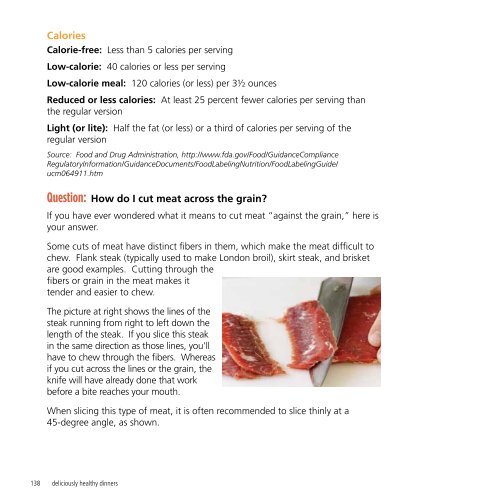Dinners_Cookbook_508-compliant
You also want an ePaper? Increase the reach of your titles
YUMPU automatically turns print PDFs into web optimized ePapers that Google loves.
Calories<br />
Calorie-free: Less than 5 calories per serving<br />
Low-calorie: 40 calories or less per serving<br />
Low-calorie meal: 120 calories (or less) per 3½ ounces<br />
Reduced or less calories: At least 25 percent fewer calories per serving than<br />
the regular version<br />
Light (or lite): Half the fat (or less) or a third of calories per serving of the<br />
regular version<br />
Source: Food and Drug Administration, http://www.fda.gov/Food/GuidanceCompliance<br />
RegulatoryInformation/GuidanceDocuments/FoodLabelingNutrition/FoodLabelingGuide/<br />
ucm064911.htm<br />
Question: How do I cut meat across the grain?<br />
If you have ever wondered what it means to cut meat “against the grain,” here is<br />
your answer.<br />
Some cuts of meat have distinct fibers in them, which make the meat difficult to<br />
chew. Flank steak (typically used to make London broil), skirt steak, and brisket<br />
are good examples. Cutting through the<br />
fibers or grain in the meat makes it<br />
tender and easier to chew.<br />
The picture at right shows the lines of the<br />
steak running from right to left down the<br />
length of the steak. If you slice this steak<br />
in the same direction as those lines, you’ll<br />
have to chew through the fibers. Whereas<br />
if you cut across the lines or the grain, the<br />
knife will have already done that work<br />
before a bite reaches your mouth.<br />
When slicing this type of meat, it is often recommended to slice thinly at a<br />
45-degree angle, as shown.<br />
138 deliciously healthy dinners
















